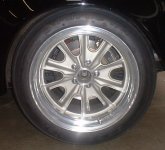

|
 |
 |
||||||||
|
| Event Schedule | Tech Articles | Vehicles | Wallpaper | Letters | Past Events | TCP-Racing | |
Tire & Wheel Information |
What type of driving? Our first step in narrowing down the selection is finding a general category of tire that suits your needs. Daily driver vehicles should have a tire that provides longer treadwear and possibly a smoother ride. The half driver, half toy cars would be better fitted with a lower profile better handling tire. This category allows the possible upsizing of the wheel which we'll go into more detail later. The third category is all out performance. While this, in my opinion is the most fun, may not be the best or legal choice for a street driven vehicle. For those of you in very wet or snowy areas you will definitely want to take weather conditions into consideration. |
|
Are bigger wheels better? Increasing the size of the wheel while decreasing the height of the tire is a simple and effective way of improving the handling performance of your car. A lower profile tire decreases sidewall deflection and enables a faster turn-in and improved cornering stability. This increase in handling responsiveness may be less noticeable with factory suspension components as opposed to a performance suspension system. (see article) Of course there is usually a trade-off for performance over ride comfort. A lower profile tire gives better handling but at the cost of increased road noise and vibration transferred on to the suspension. You will want to stay within around 3% or roughly 3/4" of the original overall diameter of the wheel and tire combination. This will keep the calibration of your speedometer and odometer fairly close to accurate. Any increase in size above this range should warrant your speedometer being recalibrated. As an example a 15" wheel with a 60 series tire could be upgraded to a 17" wheel matched to a 40 series tire. NOTE: If the wheel pictured to the right reminds you of the "Gone In 60 Seconds" car, Eleanor, you must be a fan. These 17x8 PS Engineering wheels are available and can be purchased through us. Contact our sales staff for further information. |
  |
Is wider better? Your tires contact patch is actually the only part of your vehicle to make contact with the road. A wider contact patch is usually matched with a shorter length contact patch. This gives you better handling characteristics on dry roads but does not work as effectively on extremely wet or snow covered roads. This wider area will actually allow the vehicle to ride on top of the snow. A narrower tread pattern while not a responsive on dry roads will actually be better suited to extremely wet or snowy conditions. The contact patch is narrower but longer which in a sense cuts through the snow better. Again the trade-off issue. When running a wider tire make sure there is enough wheel underneath the tire to support it. Too wide a tire on a narrow wheel may prevent the tire bead from sealing properly against the wheel. Conversely too narrow a tire on a wide wheel may give similar negative results. Classic Mustangs... Lots of people ask about tire and wheel upgrade sizes for early model Mustangs. Without making major modifications to the fender it is safe to run a 17x7 with 4.5" backspacing in the front. Tire selection is very important when running a larger diameter wheel. You should be able to turn your wheels full left and full right while the suspension is under load, without the tire making contact with the fender or fenderwell. Allow 1/2" clearance minimum for 40 and 45 series, 1" clearance for 50 series and up. Using a straight edge check backspacing from mounting surface of drum or rotor to areas where tire may hit along the inner fender well. Clearance on early Mustangs may vary as much as a 1/2" from side to side. |
|
Wheel Size |
Backspacing |
Tire Size |
|
| 1965 - 1966 Mustangs | |||
Front: |
17x8 |
4.5 |
245/40R17 |
Rear: |
17x8 |
4.5 |
255/40R17 |
| 1967 - 1973 Mustangs | |||
Front: |
17x8 |
4.5 |
245/40R17 |
Rear: |
17x9.5 |
6.5 |
295/40R17 |
| When running a larger tire and wheel combination it may necessary to roll the inner fender lip to prevent cutting the tires. Always test fit your tires before making a purchase. What works on one vehicle is not guaranteed to work on another. Beware, one manufacturer's 235/60 may actually be wider than another manufacturer's. | |||
Resources... Tirerack.com - Tirerack.com has a wealth of information about tire and wheel selection as well as a very extensive selection of tires. Be sure to check out their Tire Tech section for some very useful information and diagrams. Below are some links to specific areas of their site that may be of interest to you.
John's Mustangs & Classics (John Da Luz) |
All specifications and prices listed throughout the website and linked documents are subject to change.
|
|
© 2018 Total Control Products - A Chris Alston's Chassisworks, Inc. Brand |
Toll Free: 888.388.0298 |